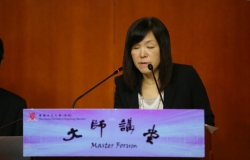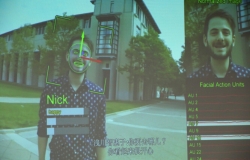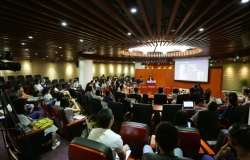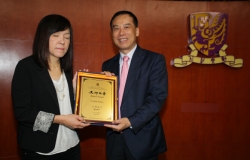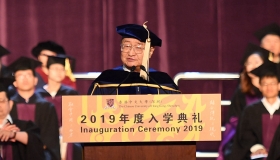Chieko Asakawa: Let the Blind “See” the Real world
“I hope my technology can help the blind to cope with real life and live independently.” On the afternoon of May 13, Dr. Chieko Asakawa, a computer scientist and IBM fellow, shared her life experience and the history of IBM accessibility research with students in CUHK(SZ). Asakawa began losing eyesight after an accident and was totally blind by the age of 14. Since 1980s, she has dedicated herself to helping blind people to live a convenient life with the help of modern technology.
Chieko Asakawa is an IBM fellow and a visiting faculty member at Carnegie Mellon University. She is now working on cognitive assistant research to help the visually impaired to access information in real life to improve life quality.
Internet is the Window to the World
Dr. Asakawa was born a normal child, but she became blind at age 14 due to a swimming accident at age 11. In 1980s, she was a lead developer in digital books, including Braille editor, Braille dictionary, Braille library and etc.. This system allows the visually impaired to read newspaper, articles and books to better understand the world.
In the 1990s, she created a voice browser that enables blind people to access the Internet using text-to-speech translations. Now, working with scientists at Carnegie Mellon University (CMU), she is developing technologies aimed at helping the blind “see” and interact more with the world around them.
A blind client once said to Dr. Asakawa that the browser opened a new world for him. After over twenty years’ development, the browser was greatly improved as pronunciation was clearer and some emotions were even added to provide a better user experience for the blind.
Let the Blind “See” the Real World
Three years ago, Chieko Asakawa saw the potential for advances in mobile computing, Internet of Things sensor networks and computer vision. She worked with Carnegie Mellon University’s Robotics Institute to try to combine Internet of Things sensors, smartphones and cognitive technologies together to usher in a new generation of accessibility aids for the blind.
This combination of multiple technologies is called cognitive assistant. NavCog is one of the applications developed by the team. It uses current sensors and cognitive technologies to locate users’ position, determine their facing directions and obtain other information about the surrounding environment by “whispering” into their ears through earbuds or sending vibration to smartphones
NavCog is now available in the App Store.
Researchers are exploring more features, such as detecting approaching people and their mood. Dr. Asakawa hopes that with the help of her technology, people with visual impairment can recognize friends who are walking towards them, greet them by names and identify their emotions when speaking to them. She hopes people with disabilities like her can give a presentation on stage without any assistance.
The first “cognitive assistant” toolkit for developers has been uploaded to the cloud through Bluemix now. The open source toolkit includes a navigation app, a map editing tool and localization algorithm to help locate users’ position, determine their facing directions and obtain other information about the surrounding environment.
Dr. Asakawa and her team want to develop a new generation of accessibility capabilities for a wide range of scenarios — shopping malls, airports, hospitals, stadiums, offices, etc.. The technology can also be used for normal people—a Take Me Home app for the elderly who get lost or a semi-autonomous wheel chair for people who have difficulty walking. They are willing to share their tools to further explore ides with researchers, developers and users.
Everything is Possible If You Never Give up
Dr. Asakawa studied English literature in college. After she joined IBM, she earned a Ph.D. degree from Tokyo University after three years’ study. During the Q&A session, one student asked Dr. Asakawa how she overcame the difficulties of transferring from English literature to computer science. She replied that she studied from 9 p.m. to midnight every day and weekends and worked the rest of the time. She never gives up. Dr. Asakawa told the students that everything is possible if you don’t give up.
Dr. Asakawa also told the students that you may encounter all kinds of challenges in life, but if you don’t give up easily and keep pursuing, you will eventually succeed. In the end, Dr. Asakawa stressed the importance of teamwork in her lecture.

